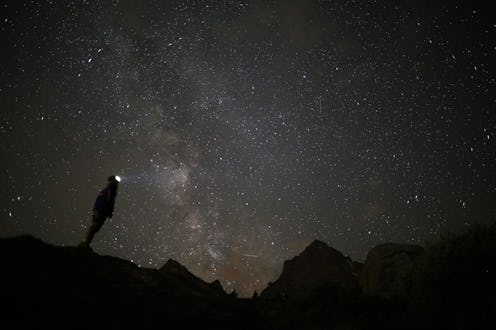Who doesn't love a good meteor shower? There's something inherently magical about wishing on a falling "star," and that magical feeling is only magnified during a full-on meteor shower — arguably the best of which is the Perseid meteor shower, which is set for its most stunning show in nearly 20 years. So if you're wondering how to watch the Perseid meteor shower, good news: I've got all the details you need to make sure you're in the right place at the right time for this celestial event, plus the 4-1-1 on why this year's Perseids are poised to be particularly spectacular.
Let's start with a little background intel, shall we? The Perseid meteor shower takes place every year when Earth passes through the cosmic trail left behind by the Comet Swift-Tuttle. This typically happens sometime between mid-July and August. This year, the Perseid meteor shower will peak on Aug. 11 and 12, also known to us mere Earth-walking mortals as this Thursday night into Friday morning. Stargazers are particularly fond of the Perseids because this meteor shower tends to produce an inordinately high percentage of bright and beautiful shooting stars — to the tune of around 100 meteors per hour on an average year. Amazing, I KNOW.
So what makes this year's Perseids an even bigger deal than normal? Well, Jupiter recently nudged ol' Comet Swift-Tuttle a tiny bit closer, so the expected meteor count could very well be double the normal rate this year. (That's 200. 200 meteors per hour, you guys. That's amazing.) You don't definitely want to miss this space rave, so here's how to catch it:
1. Set Your Clock (And Chug Some Coffee)
The best time to see the Perseids will be at or just after midnight on Thursday. If the thought of staying up past midnight on a Thursday makes you feel crotchety (and, subsequently, old AF, like me), be sure to put on a pot of coffee beforehand so you'll be nice and perky when the Perseids start to peak.
2. Find a Nice, Dark Patch of Sky
If you live in a big city, this could be harder said than done — light pollution can make seeing shooting stars next to impossible. Big buildings can obscure views of the night sky, too. Your best bet is to pack up your car and head for the countryside, my friend.
3. Look Up
Lay down a nice cozy blanket, lean back, and look up. It's really as simple as that. If you found a prime location with nothing obstructing the dark night sky, just directing your eyes upward should ensure you see your fair share of the potential 200 meteors per hour that could rain down as part of the Perseids — no telescope required. (Although if you've got one hand, by all means, bring it along with you.)
4. Livestream It
If all else fails and you just can't find an ideal spot to stargaze from (or just can't drag yourself out of your warm, snuggly bed), cue up your computer. NASA will be broadcasting the Perseid meteor shower on Ustream. You're welcome.
Images: Giphy (4)
